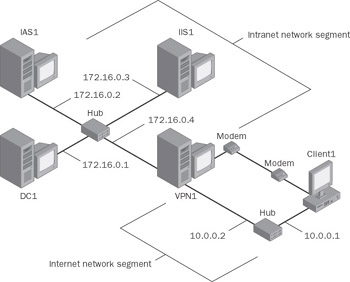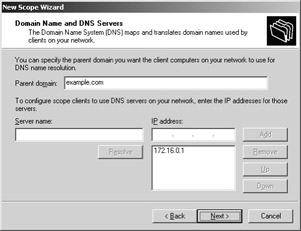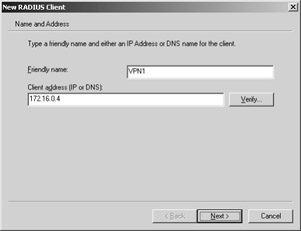Configuring the Initial Test Lab
To follow the steps in this procedure, you will need to configure five computers in a specific topology. Each computer in the lab has specific hardware and operating system requirements, which are specified in the following subsections.
To set up this test lab, you will need the following hardware and software:
-
Four computers that are capable of running members of the Windows Server 2003 family
-
One server must have two network adapters and a modem.
-
One server must have a floppy disk drive.
-
-
One computer that is capable of running Microsoft Windows XP Professional and that has a modem and a floppy disk drive
-
Two network hubs or Layer 2 switches
-
One operating system compact disc for Windows Server 2003, Enterprise Edition
-
Three operating system compact discs for Windows Server 2003, Standard Edition
-
One operating system compact disc for Windows XP Professional
Figure E-1 shows the network topology for this lab.

Figure E-1: The network topology of the Connection Manager test lab.
As shown in Figure E-1, one segment of the test lab network represents a corporate intranet and another segment represents the Internet. Connect all computers on the intranet segment to a common hub or Layer 2 switch. Connect all computers on the Internet segment to a separate common hub or Layer 2 switch.
The following subsections describe how you will set up the basic infrastructure. To reconstruct this test lab, configure the computers in the order presented. Additional sections of this appendix describe the specific configuration steps required for testing dial-up, PPTP, L2TP/IPSec, and EAP-TLS connections.
DC1
As part of setting up the basic infrastructure for the test lab, configure DC1 as the domain controller, the DNS server, and the DHCP server for a domain that is named example.com.
Perform basic installation and configuration
-
Install Windows Server 2003, Enterprise Edition, and configure the computer as a standalone server named DC1.
-
Configure the connection to the intranet segment with the Internet Protocol (IP) address of 172.16.0.1 and the subnet mask of 255.255.255.0.
Configure the computer as a domain controller
-
Click Start, click Run, type dcpromo.exe, and click OK to start the Active Directory Installation Wizard.
-
Follow the instructions in the wizard to create a domain named example.com in a new forest. Install the DNS service when prompted to do so.
-
Raise the functional level of the example.com domain to Windows Server 2003.
Install and configure DHCP
-
Install DHCP, a subcomponent of the Networking Services component.
-
Click Start, point to Administrative Tools, and click DHCP.
-
In the console tree, click dc1.example.com. On the Action menu, click Authorize to authorize the DHCP service.
-
In the console tree, right-click dc1.example.com, and then click New Scope.
-
On the Welcome page of the New Scope Wizard, click Next.
-
On the Scope Name page, type CorpNet in the Name text box and click Next.
-
On the IP Address Range page, type 172.16.0.10 in the Start IP Address text box, type 172.16.0.100 in the End IP Address text box, type 24 in the Length text box, and click Next.

-
On the Add Exclusions page, click Next.
-
On the Lease Duration page, click Next.
-
On the Configure DHCP Options page, click Yes, I Want To Configure These Options Now, and click Next.
-
On the Router (Default Gateway) page, click Next.
-
On the Domain Name And DNS Servers page, type example.com in the Parent Domain text box. Type 172.16.0.1 in the IP Address text box, click Add, and click Next.

-
On the WINS Servers page, click Next.
-
On the Activate Scope page, click Yes, I Want To Activate This Scope Now, and click Next.
-
On the Completing The New Scope Wizard page, click Finish.
Add computers to the domain
-
Open the Active Directory Users And Computers administrative tool.
-
In the console tree, double-click example.com.
-
Right-click Users, point to New, and then click Computer.
-
In the New Object – Computer dialog box, type IAS1 in the Computer Name text box and click Next.
-
In the Managed dialog box, click Next.
-
In the New Object – Computer dialog box, click Finish.
-
Follow steps 3 through 6 to create additional computer accounts for IIS1 and VPN1.
IAS1
As part of setting up the basic infrastructure for the test lab, configure IAS1 as the Remote Authentication Dial-In User Service (RADIUS) server that provides authentication, authorization, and accounting for VPN1.
Perform basic installation and configuration
-
Install Windows Server 2003, Standard Edition, and configure the computer as a member server named IAS1 in the example.com domain.
-
Configure the connection to the intranet segment with the IP address of 172.16.0.2, the subnet mask of 255.255.255.0, and the DNS server IP address of 172.16.0.1.
Install and configure Internet Authentication Service (IAS)
-
Install Internet Authentication Service, a subcomponent of the Networking Services component.
-
Click Start, point to Administrative Tools, and click Internet Authentication Service.
-
Right-click Internet Authentication Service, and then click Register Server In Active Directory. When the Register Internet Authentication Server In Active Directory dialog box appears, click OK. When the Server Registered dialog box appears, click OK.
-
In the console tree, right-click RADIUS Clients, and then click New RADIUS Client.
-
On the Name And Address page of the New RADIUS Client Wizard, type VPN1 in the Friendly Name text box, type 172.16.0.4 in the Client Address (IP Or DNS) text box, and then click Next.

-
On the Additional Information page, type the same shared secret for VPN1 in both the Shared Secret text box and in the Confirm Shared Secret text box.

-
Click Finish.
IIS1
As part of setting up the basic infrastructure for the test lab, configure IIS1 as a Web server and a file server for the example.com domain.
Perform basic installation and configuration
-
Install Windows Server 2003, Standard Edition, and configure the computer as a member server named IIS1 in the example.com domain.
-
Configure the connection to the intranet segment with the IP address of 172.16.0.3, the subnet mask of 255.255.255.0, and the DNS server IP address of 172.16.0.1.
Install and configure IIS
-
Install Internet Information Services (IIS), a subcomponent of the Application Server component.
-
Start Internet Explorer on IAS1. If the Internet Connection Wizard prompts you, configure Internet access through a LAN connection. In Internet Explorer, type http://IIS1.example.com/iisstart.htm in the Address text box. You should see a Web page titled “Under Construction.”
Configure a shared folder
-
On IIS1, use Windows Explorer to share the root folder of the drive on which you installed the operating system. Name the share ROOT, and retain the default permissions.
-
To determine whether file sharing is working correctly, on IAS, click Start, click Run, type \\IIS1\ROOT, and then click OK. You should see the files in the root folder on IIS1.
VPN1
As part of setting up the basic infrastructure for the test lab, configure VPN1 as a remote access server. VPN1 must have two network adapters and a modem.
Perform basic installation and configuration
-
Install Windows Server 2003, Standard Edition, and configure the computer as a member server named VPN1 in the example.com domain.
-
In Internet Connections, rename the connection to the intranet segment as CorpNet, and rename the connection to the Internet segment as Internet.
-
Configure the CorpNet connection with the IP address of 172.16.0.4, the subnet mask of 255.255.255.0, and the DNS server IP address of 172.16.0.1.
-
Configure the Internet connection with the IP address of 10.0.0.2 and the subnet mask of 255.255.255.0.
-
If Windows does not configure the modem automatically, start the Add Hardware Wizard, and configure the modem.
Configure Routing and Remote Access
-
Click Start, point to Administrative Tools, and click Routing And Remote Access.
-
In the console tree, right-click VPN1, and click Configure And Enable Routing And Remote Access.
-
On the Welcome To The Routing And Remote Access Server Setup Wizard page, click Next.
-
On the Configuration page, Remote Access (Dial-up Or VPN) is selected by default. Click Next.
-
On the Remote Access page, select both the VPN and Dial-up check boxes, and click Next.
-
On the VPN Connection page, click the Internet interface in Network Interfaces, and click Next.
-
On the Network Selection page, click the CorpNet interface in Network Interfaces, and click Next.
-
On the IP Address Assignment page, Automatically is selected by default. Click Next.
-
On the Managing Multiple Remote Access Servers page, click Yes, Set Up This Server To Work With A RADIUS Server, and click Next.
-
On the RADIUS Server Selection page, type 172.16.0.2 in the Primary RADIUS Server text box, type the shared secret in the Shared Secret text box, and click Next.

-
On the Completing The Routing And Remote Access Server Setup Wizard page, click Finish.
-
When a message about configuring the DHCP Relay Agent appears, click OK.
Configure DHCP Relay Agent
-
In the console tree, double-click VPN1, double-click IP Routing, and right- click DHCP Relay Agent.
-
Click Properties.
-
In the DHCP Relay Agent Properties dialog box, type 172.16.0.1 in the Server Address text box, and click Add. The server address will be added to the list. Click OK.

CLIENT1
As part of setting up the basic infrastructure for the test lab, configure CLIENT1 as a standalone computer on a separate network segment. CLIENT1 must have a modem.
-
Install Windows XP Professional, and configure the computer as a standalone computer named CLIENT1.
-
Configure the connection to the Internet segment with the IP address of 10.0.0.1 and the subnet mask of 255.255.255.0.
-
If Windows does not configure the modem automatically, start the Add Hardware Wizard, and configure the modem.
EAN: 2147483647
Pages: 128
- Using SQL Data Manipulation Language (DML) to Insert and Manipulate Data Within SQL Tables
- Working with Queries, Expressions, and Aggregate Functions
- Understanding Transaction Isolation Levels and Concurrent Processing
- Working with Ms-sql Server Information Schema View
- Repairing and Maintaining MS-SQL Server Database Files